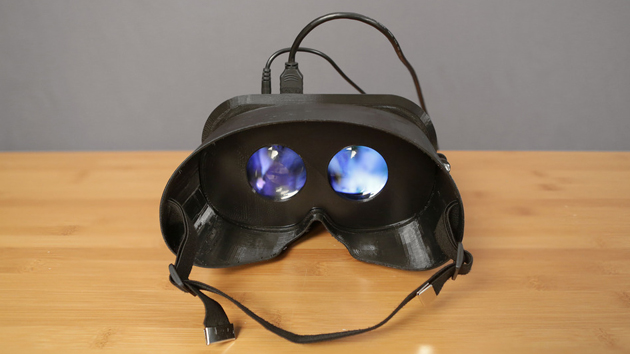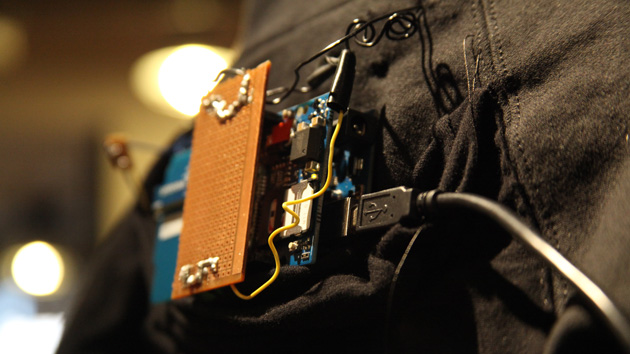Posts with «wearable» label
Nikes With Power Laces, Just in Time for Next Year

With the world’s first hoverboard being shown a few days ago, we’re on the verge of the fabulous world of tomorrow from Back to the Future. Hoverboards are cool, but there’s a wealth of other cool technology from the far-off year of 2015: Mr. Fusions, inflatable pizza, Dustbusters, and of course, Nikes with power laces. [Hunter] just built them, and with the right shoes, to boot.
[Hunter] is using the BttF-inspired Nike Air Mag shoes for this build, along with a few bits of electronics – an Arduino pro mini, a force sensing resistor, and a motor. The build began by carving out a notch in the back of the shoe for the electronics. A small bit of fishing line goes around the shoe, providing the power behind the power laces.
A force sensitive resistor under the heel of the insole tells the microcontroller when a foot is inside the shoe, and a rotary encoder on the motor shaft makes sure all the power lace cycles are the same. It’s not quite the same as the shoe seen on screen – the lower laces can’t be replicated and it’s certainly not as fast as the BttF shoes, but it does work, and as far as shoelaces are concerned, they work well.
Videos below.
Filed under: wearable hacks
Here's how you make your own 3D-printed virtual reality goggles
So you couldn't get your hands on a nice virtual reality headset like the Oculus Rift, but you'd still like something a little fancier than a cardboard display. Are you out of luck? Not if Noe Ruiz has anything to say about it. He has posted instructions at Adafruit for do-it-yourself 3D-printed goggles that can be used for either VR or as a simple wearable screen. The design mates an Arduino Micro mini computer with a display, a motion sensor and lenses; the 3D printing both adds a level of polish and lets you tailor the fit to your cranium. This definitely isn't the cheapest project (about $231 in parts) or the easiest, but it will give you head-tracking VR without having to wait for Oculus, Samsung or Sony to put out finished devices of their own. If you're up to the challenge, you'll find everything you need at the source link.
[Image credit: Noe Ruiz]
Filed under: Displays, Wearables
Source: Adafruit
This smart hoodie lets you message friends on the sly
You don't have to be a forward-thinking fashion designer or scientist to produce tech-savvy clothing. Need evidence? Just look at the smart hoodie developed by New York University grad students Alina Balean and Rucha Patwardhan. They've integrated a cellular-equipped Arduino board and switches into the wearable, letting you send messages through discreet movements; you can cover your head to text your mom, or roll up your sleeve to post on Facebook.
Filed under: Wearables
Via: The Verge
Source: Alina Balean
How-To: Brake Light Backpack for Cyclists
Woven's wearable platform for gaming, cool points and a whole lot more (video)
TshirtOS showed us one take on wearable gadgetry earlier this month, and now it's Woven's turn. This particular e-garment packs quite the selection of hardware, as you can see above -- a trio of LilyPad Arduino boards (and some custom ones), a Bluetooth module, 12 x 12 RGB LED "screen", speakers, bend sensors, a heart rate monitor, shake motors and a power pack. You'll need to accessorize, of course, with a smartphone for hardware harmony and to run companion apps. So what's it for, you ask? Well, the creators are touting it primarily as a "pervasive" gaming platform, and even seem to have a working first title in the form of SPOOKY (think gesture-based ghost-fighting). Other uses (which appear a little more conceptual) see Woven as a workout companion, TV remote, Wii controller, social network alerter or simply a fashion accessory. Check out the videos below to see it in action and imagine all the fun you could have in the five minutes before you're ushered into that padded room.
Continue reading Woven's wearable platform for gaming, cool points and a whole lot more (video)
Filed under: Wearables
Woven's wearable platform for gaming, cool points and a whole lot more (video) originally appeared on Engadget on Fri, 31 Aug 2012 05:36:00 EST. Please see our terms for use of feeds.
Permalink | Email this | CommentsWearable Fabric on the Arduino Store
We are happy to announce the first wearable kit on the Arduino Store . This kit has been made by Plug’n'Wear specifically for us. All fabrics in this kit are produced in Italy, and strongly related to a textile family business. If you want to get deeper into the story of this product have a look at Riccardo Marchesi presentation (still in Italian, soon to be traslated!) at World Wide Rome 2012.
Read over for Kit’s features
This kit features:
- 1x Circular Stretch Sensor Designed by Hannah Perner-Wilson, this circular knit stretch sensor works perfect when you need to detect tension in many projects.
- 2x Textile push button to make easy digital inputs in cloth, scarfs o bags.
- 2x Spools of Conductive thread, ready to be hooked over a sewing machine
- 2x Soft potentiometer kit will let you import analog data into your wearable project: this kit includes 1 meter of knitted conductive tape and a metal ring. Watch it in action (see video)
- 10x 1k ohm resistor
- 10x 10k ohm resistor
- 1x Textile perfboard is going to change the way you think of wearable circuits. You can sew or even solder components (SMD & through-hole) on this . It can be easily cut or sewn with a standard sewing machine. Washable. Size: 15 cm x 15 cm (6″ x 6″) / Pitch: 2.54 mm (0.1″)
- 1x Knitted Coated Copper Tape. Small conductive tape made of coated copper fine wire (112 micron). Flexible, easy to cut, sewable with a standard sewing machine, It can be easily welded ( The coating will melt and tape will be soldered). The surface of this tape has a good insulation thrughout its lenght. Resistance: 107 Ohm/m. Width: 9 mm (0.35″)
- 1x Analog Textile Press Button, working with a resistive principle (resistance goes down when you press it). It works as a bend sensor as well. By connecting more sensors together it is possible to make a matrix analog switch. Sensitive area 40mm x 40mm (1.57″x1.57″)
- 2x LilyPad LED Bright White A simple, very bright, 250mcd, white LED LilyPad
source: [arduino store]
Intutive training aid using wearable electronics
A yet another application of wearable electronics – to train blind athletes with pressure feedback.
A work that is a part of the Innovation Design Engineering (IDE) masters programme run jointly by Imperial College and the Royal College of Art has a team designing it, as part of course. Mining company Rio Tinto has launched a ‘Sports Innovation Challenge’ for new paralympic opportunities, ranging from equipment through to radical new sporting events and competition models.
“As a visually impaired person, you don’t develop the same kind of kinaesthetic awareness — so we began with how you can rebuild body awareness and how you can actually have a feeling of where your limbs are in space, if you lost your sight, for instance,” said IDE student Benedict Copping.
Noting that the vast majority of sighted athletes use coaching demonstrations or video-analysis techniques to perfect complex motion skills, Copping’s team wanted to find a way for blind athletes to similarly benefit.
The design comprises of wearable joint pads that record the position of the limb in space and keep this as a reference against predetermined angles, giving a graded vibration feedback as they match up.
Flex sensors, vibration motors (like those used in mobile phones) and an Arduino mini pro electronics board (for computation) are some of the easily available components that are used.
“If you’re visually impaired, because you can’t reflect on somebody else doing the motion, the coach moves the hand around, so what he’ll do is get the first position and press a button, store that, then [get a] second position, store that — so a combination of points together will build a picture. Then when you actually change movements, it will vibrate more and more until you get the correct position,” Copping said.
For creating the winning design, the Ghost team (which also includes Jason Cheah, Shruti Grover and Idrees Rasouli) will receive undisclosed funding from Rio Tinto to further develop the technology.
[Via: TheEngineer]









